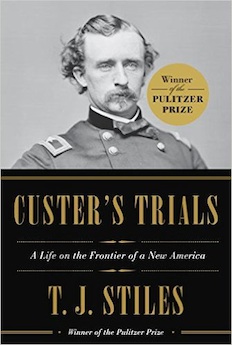By Allen D. Boyer
This fine biography, which last month garnered T. J. Stiles his second Pulitzer Prize, is a marvelously fresh portrait of a man we thought we knew—a brilliant life of a soldier best known for the spectacular and disastrous manner of his death. With this book, Stiles writes, he has sought “to change the camera angle—to examine Custer’s life as it was lived…. He captured the American imagination long before the Little Bighorn, even before he went west. That mean he had a significance independent of his demise.”
Armstrong Custer (the family called him that, or Autie) was born in the winter of 1839, in a log house in Ohio. Before Armstrong reached West Point, he had been apprenticed to a furniture-maker and taught in small-town schools. As a cadet, he made his name as a prankster and roisterer, and finished last in his class.
Custer’s Trials opens with Armstrong’s first court-martial. In 1861, while still at West Point, he was charged with allowing two cadets to settle their differences with a fist-fight. Custer pleaded guilty but asked his judges to let him go to war: soldiering was his avocation, “one which offers to my ambition the most glorious career.” They reprimanded him and let him go south as a cavalry lieutenant.
By 1865, Custer would be commanding a cavalry division, but other hearings followed. The Army questioned him about a thoroughbred stallion that his men had seized for him in Virginia, weeks after Appomattox. Congressional committees called him to testify (and Custer always told Congressmen what he believed they wanted to hear). The Army court-martialed him for having deserters shot, and one captain had him indicted in state court for murder. He acquired a doubtful reputation: “that of a man selfishly indifferent to others, and ruthlessly determined to make himself conspicuous at all hazards.”
Whenever Custer faced discipline, he counted on redeeming himself with a victory on the battlefield. He was good at spotting ambushes and timing cavalry charges, and he led from the front. But only on the battlefield was his judgment sound. He gambled ceaselessly, at horses, cards, and stocks. He was always ready to chase a skirt or dine with an opera-singer. Predictably, he loved the stage, and there was a strange edge to his theatricality. Not only did he take for his uniform a black velveteen jacket with gold buttons and frogging, worn with a red cravat; he attended one fancy-dress ball as Louis XVI and another as the devil, in red silk tights.
Custer’s own letters are lively, often surprisingly intimate, providing material which Stiles uses with a novelist’s flair. The book’s epigraph is drawn from Tolstoy—“how much he suffered merely to appear in his own eyes what he wished to be!”—and Custer’s impetuousness recalls another cavalry officer whose life bolts out of control, Count Vronsky in Anna Karenina. Stiles studies Custer as a cultural figure. He saw the same war as Ambrose Bierce, but Bierce emerged embittered and sardonic, Custer blithely untouched. On duty in Reconstruction-era Kentucky, he balked at enforcing the Ku Klux Klan Act. Out West, he hired scouts like Wild Bill Hickock and Buffalo Bill Cody. On the Wall Street of The Gilded Age and Chapters of Erie, he tried to sell shares in a dubious silver-mine. On the strength of magazine articles he had written, James Gordon Bennett Jr. tried to flatter him into writing for the New York Herald.
Bound up with Armstrong’s life are the stories of two remarkable, formidable women. Elizabeth Bacon Custer (who has earned her own biography, by Shirley A. Leckie) was Armstrong’s bride, his widow, his biographer, and his champion. Libbie Custer had more business sense than Armstrong, but she may have shared his flaws. She tolerated his gambling and womanizing, she demanded the attentions of his officers, and her flamboyance mirrored his own; when Armstrong cut short his celebrated flowing locks, Libbie had them made into a wig.
The second woman, Eliza Brown, ran Custer’s mess and kitchen for six years. Born a slave in Virginia, she walked to the Union lines during the war, and was about eighteen when the twenty-three-old general hired her as a cook. Custer made his headquarters a convivial place, and Eliza was the woman who ensured that officers and couriers could always enjoy a plate of hot biscuits (on her own authority, she sheltered other escaping contrabands). White troopers joshingly called her the Queen of Sheba and black troopers, “Buffalo Soldiers” from the Fort Riley garrison, spaded her garden. Eventually, Libbie and Eliza quarreled, and Eliza left—making her own path forward, as the wife of a black lawyer in Ohio.
And as for the end of Custer’s life—Stiles does not follow the Seventh Cavalry’s march to the Little Bighorn. In his penultimate chapter, he takes leave of Custer a month before, in May 1876, when he paraded his men through Fort Abraham Lincoln and then headed west, while the regimental band played “Garry Owen.” The last chapter speaks in the measured tones of an Army inquiry, Custer’s final trial, a hearing where officers reviewed the mute evidence found at the site of the Boy General’s last stand. Fittingly, Stiles ends his narrative where Custer the man was finally still and silent, and our continuing discussion of his fate had just begun.
Allen D. Boyer (ΦBK, Vanderbilt University, 1977) is a lawyer and writer in New York City. Vanderbilt University is home to the Alpha of Tennessee Chapter of Phi Beta Kappa.




